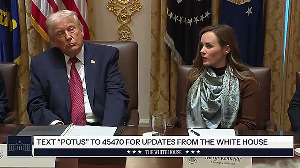The Indian machine tool industry is tiny in terms of turnover (Rs 1,300 crore -- Rs 13 billion -- last year) but is the foundation for the multi-billion dollar engineering sector. The last two years have seen a revival in the fortunes of the Indian machine tool industry triggered by an investment boom in manufacturing.
The two-wheeler industry, for instance, is currently adding a capacity of 700,000 vehicles every year, calling for an overall investment of close to Rs 1,000 crore (Rs 10 billion) per annum, of which at least 60 per cent would be in the form of machine tools.
However, the Indian machine tool industry is not able to exploit this opportunity to the fullest. One reason is a lack of capacity. Although the bigger machine tool companies are scrambling to increase capacity, the additional production will materialise only by 2006 or 2007. Meanwhile, European, Taiwanese and Korean machine tool makers are harvesting the Indian orders.
Again, due to a neglect of investment in technology upgradation during the recession years, Indian machine tool manufacturers have been slow in coming up with machines of contemporary international technology, such as hard machining and high-speed machining, demanded by their customers, particularly the multinationals.
With the need to frequently introduce new models as a competitive measure, the two-wheeler industry has switched over from high flow, low flexibility sequential line manufacturing to highly flexible, cell-based manufacturing requiring high productivity, multi-tasking machines with low footprints. Barring a few exceptions, the Indian machine tool industry is still not geared to design and supply such machines.
At a recent machine tool industry conclave in Goa, a Japanese two-wheeler manufacturer pointed out that Indian machine tools are way off international benchmarks when it comes to reliability, plug-and-play capability, long-term precision, down time, safety, power consumption, operating noise level, and TPM-- ( Total Productive Maintenance) friendliness. There was also a grouse about Indian machine tool vendors rarely sticking to delivery commitments.
Of course, the machine tool makers have their own excuses, such as the sharp rise in iron and steel costs and the failure of their parts vendors, who are mostly small units, to stick to quality and delivery commitments. But these excuses do not cut much ice with the customers.
The Japanese two-wheeler maker, for instance, started off with almost 100 per cent Indian machines for its initial investment in financial year 2001 but switched to 30 per cent imported machines in 2004 and 37 per cent in 2005. The two-wheeler sector is today importing nearly two-thirds of its requirements of machine tools.
What can be done to shore up the position of the Indian machine tool industry?
For one, manufacturers must improve their internal practices so as to maximise use of in-built capacity. The slack is as high as 50 per cent of current production levels in many companies. This itself will improve their delivery capability.
Our machine tool companies need to invest substantially more in IT on the business side, such as supply chain management and customer relationship management in order to improve deliveries and handle complaints before they become a source of friction. With their parts vendors, they should change their relationships from being just customers to being partners in development.
More attention needs to be paid to post-supply monitoring of performance at the customer end, perhaps through annual maintenance contracts.
Indian machine tools are cost-competitive where custom designing is concerned. For instance, thanks to the encouragement and close association of its customer, the Bangalore-based Bharat Fritz Werner Ltd was able to develop and deliver, for the first time in India, a complex nine-axis CNC multi-tasking machine for machining rear axle housings of commercial vehicles in a single set up.
This single machine does the job of a line of machines in the existing practice at the customer end. If the customer had imported a similar machine, it would have cost him twice the amount, not to mention the huge cost of servicing later on.
The problem here is that these design efforts are engineering skill-intensive. Unfortunately, the Indian machine tool industry finds it difficult to hang on to engineering talent which is sucked away by the IT sector with attractive emoluments.
Since many of the critical components of a modern CNC machine tool are not made in the country, the government needs to permit these components to be imported duty free. This should considerably improve the price competitiveness of Indian machine tools, as together these components with the current duty levels, account for nearly 40 per cent of the cost of a machine.
There is considerable scope for exporting machine tools from here to countries such as Poland, Czechoslovakia and Turkey, which are emerging as major auto component suppliers to western Europe and west Asia, despite competition from Taiwan and Korea. This was proven by the excellent response that the two dozen-odd Indian machine tool companies got when they participated as exhibitors at the international machine tool show -- EMO -- in September this year at Hannover.
It will be interesting to see how this midwife to the manufacturing industry fares in the next few years. For those who think big and act upon it, growth is assured, even if the domestic market starts to peter out. The others may barely survive. As Surinder Kapoor, CMD of Sona Koyo Steering Systems Ltd bluntly put it in his inaugural address at the Goa conference: " In the future, there will only be the fast and the dead."





